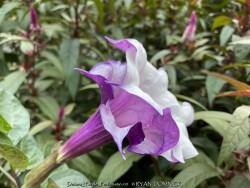

***Description for this plant available with future update!***
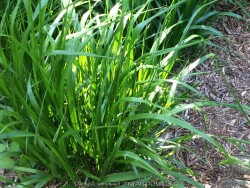

American Beakgrain (Diarrhena obovata) as a native ornamental grass found in rich woodlands in eastern North America. It features bright glossy green foliage about 2 feet tall. It is strongly vertical with little flopping until Seed heads weigh it down late in the season. With it being somewhat of a rarity to have an ornamental grass tolerate shade, American beak grass Along with inland sea oats and Korean Feather Grass help fill that niche. American beak grass prefers rich average to moist soil but will tolerate some dry shade of in rich soil. Seed heads are attractive but not persisting very long: it is an excellent source of food for birds and small mammals. Fall color is a gorgeous golden tint. Seedlings will germinate freely in the area around the mother plants. If this is not desired, simply keep the area mulched. Spreading by rhizomes will also occur after a few years. For the home garden in rich well irrigated areas, this species can be too aggressive. Use as a mass planting in any shaded area allowing extra room. However, in a difficult dry-shade garden, it will thrive, flower, and be relatively tame without much spread. Mulch will also stop self-seeding. It is one of the few plants that can survive under an established Silver Maple! Now if you need a plant to prevent soil erosion along streams, use this re-seeding to your advantage! As it reseeds easily and can expand aggressively within a couple of years, it makes a solid root mat in moist erosion-prone loam soils.
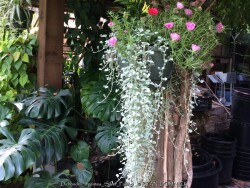

Silver Falls Dichondra / Silver Nickel Vine (Dichondra argentea 'Silver Falls') is a annual in Kansas gardens; quickly fills space providing a contrast for other flowering annuals. Vigorous, fan-shaped silver foliage grows on silver stems; very heat and drought tolerant. Very strongly trailing plant is a fun component in hanging baskets.
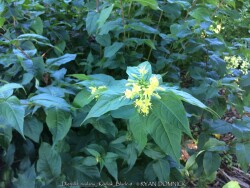

Looking for an adaptable native plant that's drought-tolerant, deer-resistant and colorful? This is it! Diervilla just got a lot more colorful: this tough, easy-growing shrub (Diervilla rivularis 'Kodiak Black') is a standout with its dark burgundy-black foliage. The color is especially intense in spring and autumn. The bright yellow flowers add contrast in early summer. This is a durable native that thrives in sun or shade, and is a very useful landscape plant.Top three reasons to grow Kodiak® Black Diervilla:1.One of the best shade-tolerant shrubs (though color is more intense in sun or part shade) 2.Never without clusters of yellow flowers during the summer 3.Dramatic black-purple foliage all season with vivid red tones in autumn. Uses Notes:Naturalizing; mass plantings. Maintenance Notes: Adaptable to most soils, including dry ones. Trim in spring and apply a controlled-release fertilizer. Though it is sometimes called "bush honeysuckle," Diervilla is not invasive. In Eastern Kansas, this cultivar performs WELL with just about everything nature has to challenge it! Heat and drought are tolerated if in shade or morning sun. Cold tolerance is no problem. No disease or pest problems. Great plant for dry-shade. Native to North America. All Proven Winners® plants are legally propagated, healthy and vigorous, true to name, and tagged with color pictures and growing information.
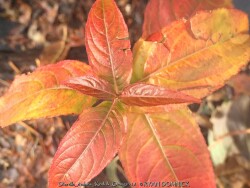

Looking for a durable native plant that will thrive in sun or shade, and is drought-tolerant? Deer-resistant, too? You've got it! This shrub (Diervilla rivularis 'Kodiak Orange') pushes fall color to the limits with its glowing orange fall foliage. It lights up the fall landscape, making it an eco friendly alternative to burning bush. Bright yellow flowers in early summer add to its appeal. A durable native plant that thrives in sun or shade, its is drought-tolerant, deer-resistant, and can even grow in dry shade. This is an excellent landscape plant that will succeed in even challenging sites. Top three reasons to grow Kodiak® Orange diervilla: 1.Tolerant of dry shade (though color is best with at least some sun) 2.Never without yellow flower clusters in the summer. 3.Orange new growth and glowing orange-red fall foliage. Uses Notes: Naturalizing; mass plantings. Maintenance Notes: Adaptable to most soils, including dry ones. Trim in spring and apply a controlled-release fertilizer. Though it is sometimes called "bush honeysuckle," Diervilla is not invasive like certain honeysuckles are. In Eastern Kansas, this cultivar performs WELL with just about everything nature has to challenge it! Heat and drought are tolerated if in shade or morning sun. Cold tolerance is no problem. No disease or pest problems. Great plant for dry-shade. Native to North America. All Proven Winners® plants are legally propagated, healthy and vigorous, true to name, and tagged with color pictures and growing information.
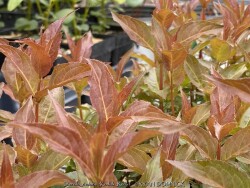

Kodiak® Red Diervilla (Diervilla rivularis 'Kodiak Red') provides rugged beauty for the toughest spots in your landscape. Kodiak® Red diervilla is a native flowering shrub that looks great while shrugging off shade and problem soils. New growth emerges in spring with a deep burgundy tone, and turns vivid red in fall. During summer, leaves have a red edge and clusters of small yellow flowers appear all season. It's a simple but beautiful way to add low-maintenance color to parts of your yard that have been difficult to landscape. Top reasons to grow Kodiak Red diervilla: 1.One of the toughest landscape plants around! 2.Foliage emerges red and turns bright red in fall. 3.Yellow flowers all summer long. Diervilla needs very little care - if you'd like to prune it, do so in early spring. It does not require regular pruning, but if it starts to get a little sparse as it matures, cut it back to the ground in early spring for a fresh start. Uses Notes: The long, straight stems and neat foliage of diervilla makes it an excellent filler for cut flower arrangements. Maintenance Notes: Diervilla needs very little care - if you'd like to prune it, do so in early spring. It does not require regular pruning, but if it starts to get a little sparse as it matures, cut it back to the ground in early spring for a fresh start. Diervilla is sometimes called "bush honeysuckle," and though it is related to honeysuckle, diervilla flowers are not fragrant. However, more importantly, diervilla is NOT invasive, so it's a safe choice for planting anywhere. In Eastern Kansas, this cultivar performs WELL with just about everything nature has to challenge it! Heat and drought are tolerated if in shade or morning sun. Cold tolerance is no problem. No disease or pest problems. Great plant for dry-shade. Native to North America. All Proven Winners® plants are legally propagated, healthy and vigorous, true to name, and tagged with color pictures and growing information.
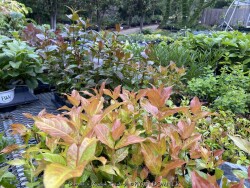

Looking for a durable native plant that will thrive in sun or shade, and is drought-tolerant? Deer-resistant, too? You've got it! This shrub (Diervilla x 'Kodiak Fresh') gives a new look to Diervilla with its bright lime-yellow foliage in summertime, always accompanied by bright yellow flowers. Like the other members of the Kodiak series, it lights up the fall landscape, making it an eco-friendly alternative to burning bush. A durable native plant that thrives in sun or shade, it is drought-tolerant, deer-resistant, and can even grow in dry shade. This is an excellent landscape plant that will succeed in even challenging sites. Top three reasons to grow Kodiak® Fresh diervilla: 1.Tolerant of dry shade (though color is best with at least some sun) 2.Never without yellow flower clusters in the summer. 3.Orangey-red new growth, persistent lime coloring, and glowing orange fall foliage. Uses Notes: Naturalizing; mass plantings. Maintenance Notes: Adaptable to most soils, including dry ones. Trim in spring and apply a controlled-release fertilizer. Though it is sometimes called "bush honeysuckle," Diervilla is not invasive like certain honeysuckles are. In Eastern Kansas, this cultivar performs WELL with just about everything nature has to challenge it! Heat and drought are tolerated if in shade or morning sun. Cold tolerance is no problem. No disease or pest problems. Great plant for dry-shade. Native to North America. All Proven Winners® plants are legally propagated, healthy and vigorous, true to name, and tagged with color pictures and growing information.


Autumn Shield Fern, is also known as Dryopteris erythrosora
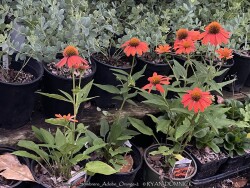

>>>>> Echinacea purpurea is an herbaceous perennial native to parts of eastern and midwestern United States most common in Missouri and Arkansas. Its habitats include dry open woods, prairies and barrens. Echinacea are native to North America, featuring sunflower-like flowers with a dark center and colorful petals. Colors on native plants include purple, magenta, white, yellow. Intensive breeding efforts to fish out recessive genes have brought bright orange and red into the picture. Flowers occur in early to mid summer often continuing into fall especially if dead-headed. Its individual flowers (florets) within the flower head are two-toned, having both male and female organs in each flower. (hermaphroditic) Bees and butterflies including the monarch are common pollinators. The dead flowers are attractive to some for winter interest but for those wanting a tidy your garden, they can be trimmed early. Leaving some dried seed heads will be beneficial for wildlife and provide winter food for finches and other birds. Best growth generally occurs in full to part sun with well drained soils with low to average moisture. In Eastern Kansas, typically our 40 inches of rainfall is sufficient without extra water. Coneflower can also handle short one to two day flooding events and are sometimes used along the higher perimeter of rain gardens to bring in pollinators. Coneflower mixes well with many other types of plants ranging from other native plants to evergreens to hardy tropicals. Rabbits can be a problem young immature plants. A popular method of control is covering the plant with an upside down bowl-shaped chicken wire cage for the first year to allow basil foliage to establish well. You can quickly make these yourself with a low cost roll of chicken wire. Mature plants especially in groups with other mature landscaping generally do not have rabbit problems. Flowers are also popular in the florist industry as cut flowers or in the cottage garden. The genus echinacea has undergone intense breeding with the introduction of hundreds of new cultivars in the last 10 years.
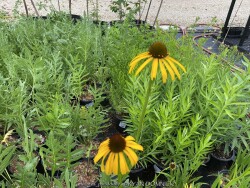

>>>>> Echinacea purpurea is an herbaceous perennial native to parts of eastern and midwestern United States most common in Missouri and Arkansas. Its habitats include dry open woods, prairies and barrens. Echinacea are native to North America, featuring sunflower-like flowers with a dark center and colorful petals. Colors on native plants include purple, magenta, white, yellow. Intensive breeding efforts to fish out recessive genes have brought bright orange and red into the picture. Flowers occur in early to mid summer often continuing into fall especially if dead-headed. Its individual flowers (florets) within the flower head are two-toned, having both male and female organs in each flower. (hermaphroditic) Bees and butterflies including the monarch are common pollinators. The dead flowers are attractive to some for winter interest but for those wanting a tidy your garden, they can be trimmed early. Leaving some dried seed heads will be beneficial for wildlife and provide winter food for finches and other birds. Best growth generally occurs in full to part sun with well drained soils with low to average moisture. In Eastern Kansas, typically our 40 inches of rainfall is sufficient without extra water. Coneflower can also handle short one to two day flooding events and are sometimes used along the higher perimeter of rain gardens to bring in pollinators. Coneflower mixes well with many other types of plants ranging from other native plants to evergreens to hardy tropicals. Rabbits can be a problem young immature plants. A popular method of control is covering the plant with an upside down bowl-shaped chicken wire cage for the first year to allow basil foliage to establish well. You can quickly make these yourself with a low cost roll of chicken wire. Mature plants especially in groups with other mature landscaping generally do not have rabbit problems. Flowers are also popular in the florist industry as cut flowers or in the cottage garden. The genus echinacea has undergone intense breeding with the introduction of hundreds of new cultivars in the last 10 years.
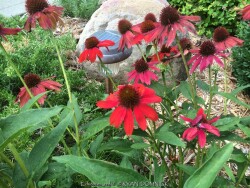

>>>>> Echinacea purpurea is an herbaceous perennial native to parts of eastern and midwestern United States most common in Missouri and Arkansas. Its habitats include dry open woods, prairies and barrens. Echinacea are native to North America, featuring sunflower-like flowers with a dark center and colorful petals. Colors on native plants include purple, magenta, white, yellow. Intensive breeding efforts to fish out recessive genes have brought bright orange and red into the picture. Flowers occur in early to mid summer often continuing into fall especially if dead-headed. Its individual flowers (florets) within the flower head are two-toned, having both male and female organs in each flower. (hermaphroditic) Bees and butterflies including the monarch are common pollinators. The dead flowers are attractive to some for winter interest but for those wanting a tidy your garden, they can be trimmed early. Leaving some dried seed heads will be beneficial for wildlife and provide winter food for finches and other birds. Best growth generally occurs in full to part sun with well drained soils with low to average moisture. In Eastern Kansas, typically our 40 inches of rainfall is sufficient without extra water. Coneflower can also handle short one to two day flooding events and are sometimes used along the higher perimeter of rain gardens to bring in pollinators. Coneflower mixes well with many other types of plants ranging from other native plants to evergreens to hardy tropicals. Rabbits can be a problem young immature plants. A popular method of control is covering the plant with an upside down bowl-shaped chicken wire cage for the first year to allow basil foliage to establish well. You can quickly make these yourself with a low cost roll of chicken wire. Mature plants especially in groups with other mature landscaping generally do not have rabbit problems. Flowers are also popular in the florist industry as cut flowers or in the cottage garden. The genus echinacea has undergone intense breeding with the introduction of hundreds of new cultivars in the last 10 years.


Pale Purple Coneflower, is also known as Echinacea pallida
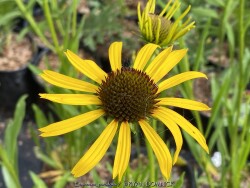

Yellow Coneflower, is also known as Echinacea paradoxa
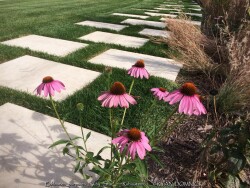

>>>>>Echinacea purpurea is an herbaceous perennial native to parts of eastern and midwestern United States most common in Missouri and Arkansas. Its habitats include dry open woods, prairies and barrens. Echinacea are native to North America, featuring sunflower-like flowers with a dark center and colorful petals. Colors on native plants include purple, magenta, white, yellow. Intensive breeding efforts to fish out recessive genes have brought bright orange and red into the picture. Flowers occur in early to mid summer often continuing into fall especially if dead-headed. Its individual flowers (florets) within the flower head are two-toned, having both male and female organs in each flower. (hermaphroditic) Bees and butterflies including the monarch are common pollinators. The dead flowers are attractive to some for winter interest but for those wanting a tidy your garden, they can be trimmed early. Leaving some dried seed heads will be beneficial for wildlife and provide winter food for finches and other birds. Best growth generally occurs in full to part sun with well drained soils with low to average moisture. In Eastern Kansas, typically our 40 inches of rainfall is sufficient without extra water. Coneflower can also handle short one to two day flooding events and are sometimes used along the higher perimeter of rain gardens to bring in pollinators. Coneflower mixes well with many other types of plants ranging from other native plants to evergreens to hardy tropicals. Rabbits can be a problem young immature plants. A popular method of control is covering the plant with an upside down bowl-shaped chicken wire cage for the first year to allow basil foliage to establish well. You can quickly make these yourself with a low cost roll of chicken wire. Mature plants especially in groups with other mature landscaping generally do not have rabbit problems. Flowers are also popular in the florist industry as cut flowers or in the cottage garden. The genus echinacea has undergone intense breeding with the introduction of hundreds of new cultivars in the last 10 years. Sunset Coneflower / Red-Orange Coneflower (Echinacea x Sunset) features red-orange and pinkish flowers. Most orange or red types if allowed to self-seed will produce purple flowering plants.
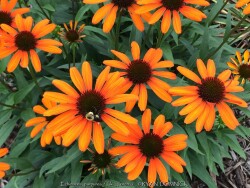

Echinacea purpurea is an herbaceous perennial native to parts of eastern and midwestern United States most common in Missouri and Arkansas. Its habitats include dry open woods, prairies and barrens. Echinacea are native to North America, featuring sunflower-like flowers with a dark center and colorful petals. Colors on native plants include purple, magenta, white, yellow. Intensive breeding efforts to fish out recessive genes have brought bright orange and red into the picture. Flowers occur in early to mid summer often continuing into fall especially if dead-headed. Its individual flowers (florets) within the flower head are two-toned, having both male and female organs in each flower. (hermaphroditic) Bees and butterflies including the monarch are common pollinators. The dead flowers are attractive to some for winter interest but for those wanting a tidy your garden, they can be trimmed early. Leaving some dried seed heads will be beneficial for wildlife and provide winter food for finches and other birds. Best growth generally occurs in full to part sun with well drained soils with low to average moisture. In Eastern Kansas, typically our 40 inches of rainfall is sufficient without extra water. Coneflower can also handle short one to two day flooding events and are sometimes used along the higher perimeter of rain gardens to bring in pollinators. Coneflower mixes well with many other types of plants ranging from other native plants to evergreens to hardy tropicals. Rabbits can be a problem young immature plants. A popular method of control is covering the plant with an upside down bowl-shaped chicken wire cage for the first year to allow basil foliage to establish well. You can quickly make these yourself with a low cost roll of chicken wire. Mature plants especially in groups with other mature landscaping generally do not have rabbit problems. Flowers are also popular in the florist industry as cut flowers or in the cottage garden. The genus echinacea has undergone intense breeding with the introduction of hundreds of new cultivars in the last 10 years. Several cultivars featuring the break-thru orange color. Older varieties were less vigorous but new varieties are much improved. Most orange or red types if allowed to self-seed will produce purple flowering plants.
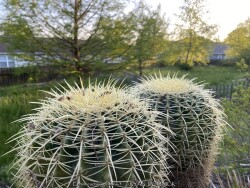

Golden Barrel Cacti (Echinocactus grusonii) are known for their bright yellow spines. Native to deserts in Mexico, it's usually grown as a patio or house plant in Kansas. In the wild, established golden barrel cacti are hardy to 13 degrees F for short periods of time. Grow in full sun with no extra watering except that which comes from rainfall. Repotting may or may not be needed depending on how large you want the plant to grow; plants can continue to grow taller and tolerate extremely root-bound pots but may need wind bracing. If repotting, make sure to use a sharp draining low organic cactus mix with plenty of sand and perlite. Potted plants are hardy to at least 25 degrees F for a short time if kept dry so you are ok if you miss the first light frost. Do not allow the pot with rootball to freeze solid though. Before extreme cold occurs, move to a bright interior window over the winter with no watering and keep above freezing. As a winter house plant, it will look presentable all winter long with just no waterings.(also to prevent soft winter growth) As a permanent house plant, provide bright light and allow the soil to dry between waterings for many years of carefree enjoyment. Plants grown permanently indoors may begin to elongate stretching for light and lose their spine color. It can be hard to reproduce the intense UV sunlight they need so moving outside for the summer is best. Generally if moving outside for the summer, allow 1-2 weeks of part shade or morning sun before placing in full sun. Plants with time to acclimate will thrive in full sun but be careful not to rush it or sunburning will occur. Potted plants are very low maintenance. I have never seen any insect problems on this plant.


>>>>>Repeated or successive cold winters with complete foliage loss seem to be an issue with this and many evergreen zone 6/7 plants. One occasional difficult winter followed by mild winters is more tolerable. This is, however, a very vigorous growing plant so generally will recover in one summer with decent watering and fertilizer.
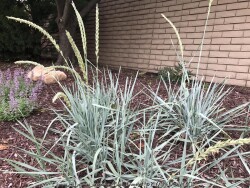

Blue Dune Lyme Grass, is also known as Elymus / Leymus arenarius 'Blue Dune'


Barrenwort (Epimedium) features compact dainty mounds of green to colored weed-resistant foliage. Wispy flowers appear above emerging foliage in mid-spring. Improved breeding has resulted in many different flower colors even including orange. Semi-evergreen foliage can sometimes look bedraggled by late summer if there is too much overhead watering and humidity. Barrenwort prefers average to dry garden conditions and even thrive and dry shade. Plantings can thrive for decades if in the right spot; there is no such thing as overcrowding for Barrenwort. When planted in mass, growth is slow at first but eventually a cake-like rhizome system will form and completely smother out any weeds and compete well with trees for water and nutrients. While barrenwort can tolerate full sun, they prefer part to full shade. Sun burning is possible with temperatures over 100° and there are better plants to use in hot areas. Due to slow spreading growth, you shouldn't leave very much room in-between barrenwort plants or you will be waiting many years for the patch to fill in. Weeds can be a problem in that open area between plants if spacing is too wide. We recommend 9-12" spacing and use for small nooks in the shade garden. If planning for a larger area, still figure on the tight spacing but allow for a higher budget that you will consider a permanent investment. Barrenwort is a real trooper for the dry shade garden!
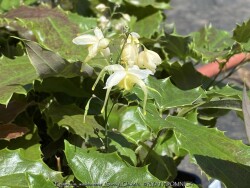

Barrenwort (Epimedium) features compact dainty mounds of green to colored weed-resistant foliage. Wispy flowers appear above emerging foliage in mid-spring. Improved breeding has resulted in many different flower colors even including orange. Semi-evergreen foliage can sometimes look bedraggled by late summer if there is too much overhead watering and humidity. Barrenwort prefers average to dry garden conditions and even thrive and dry shade. Plantings can thrive for decades if in the right spot; there is no such thing as overcrowding for Barrenwort. When planted in mass, growth is slow at first but eventually a cake-like rhizome system will form and completely smother out any weeds and compete well with trees for water and nutrients. While barrenwort can tolerate full sun, they prefer part to full shade. Sun burning is possible with temperatures over 100° and there are better plants to use in hot areas. Due to slow spreading growth, you shouldn't leave very much room in-between barrenwort plants or you will be waiting many years for the patch to fill in. Weeds can be a problem in that open area between plants if spacing is too wide. We recommend 9-12" spacing and use for small nooks in the shade garden. If planning for a larger area, still figure on the tight spacing but allow for a higher budget that you will consider a permanent investment. Barrenwort is a real trooper for the dry shade garden! Sandy Claws Barrenwort (Epimedium wushanense 'Sandy Claws') features long, lance-shaped leaves and spiny margins (not sharp). Newly emerging foliage has dramatic maroon coloring unique to the shade garden. The color mellows to dark green by summer. The cream-colored flowers contrast beautifully with the brilliantly colored foliage. Growth is faster and height is taller at 12-16" Albeit still slow compared to other perennials.
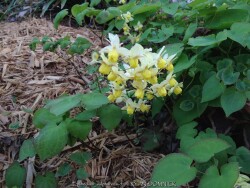

Barrenwort (Epimedium) features compact dainty mounds of green to colored weed-resistant foliage. Wispy flowers appear above emerging foliage in mid-spring. Improved breeding has resulted in many different flower colors even including orange. Semi-evergreen foliage can sometimes look bedraggled by late summer if there is too much overhead watering and humidity. Barrenwort prefers average to dry garden conditions and even thrive and dry shade. Plantings can thrive for decades if in the right spot; there is no such thing as overcrowding for Barrenwort. When planted in mass, growth is slow at first but eventually a cake-like rhizome system will form and completely smother out any weeds and compete well with trees for water and nutrients. While barrenwort can tolerate full sun, they prefer part to full shade. Sun burning is possible with temperatures over 100° and there are better plants to use in hot areas. Due to slow spreading growth, you shouldn't leave very much room in-between barrenwort plants or you will be waiting many years for the patch to fill in. Weeds can be a problem in that open area between plants if spacing is too wide. We recommend 9-12" spacing and use for small nooks in the shade garden. If planning for a larger area, still figure on the tight spacing but allow for a higher budget that you will consider a permanent investment. Barrenwort is a real trooper for the dry shade garden! Epimedium x versicolor 'Sulphureum' is a faster spreading, more robust yellow flowering variety. Albeit still very slow compared to other perennials.
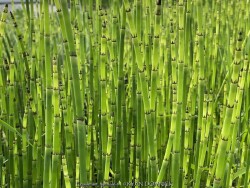

Horsetail Reed (Equisetum hyemale) is a very primitive "Dinosaur" plant with a one-of-a-kind appearance. Tube-like segmented stems grow vertical creating a dense bamboo-like appearance when grown properly in a pot or edging. The evergreen stems (down to -30 degrees F) are particularly noticeable in winter and can provide significant interest to the landscape. It is mostly used as a native erosion control plant in large areas along streams and wet wooded areas. For the home garden, the species is generally too aggressive to mix with other plants unless contained. The best use is as a marginal water garden plant in a sealed container. Horsetail rhizomes cannot spread thru open water or hop over an edge in the open air. If planted in the garden and once established, it is extremely difficult to remove by digging because its rhizomes spread wide and deep. Roundup is not effective against primitive plants such as horsetail and mosses. If planted in the garden, use professional soil barriers or no-fail sealed planters (no drainage holes ok) to restrict growth. Native to large portions of Eurasia, Canada and the U.S., including Kansas, equisetum is the single surviving genus of a class of primitive vascular plants dating back to the mid-Devonian period (350 + million years ago). As a plant evolved before twigs and leaves, Horsetail Reed is a non-flowering, seedless plant that reproduces by spores.
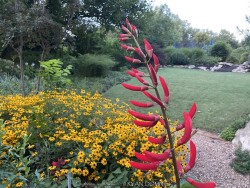

>>>>>In our trial gardens in Lawrence, KS (zone 6a), an established specimen planted on the south wall of a house with 6-12" of leaf mulch survived -17 degrees F. During the arctic blast of February, 2021, lows down to -17 degrees F on Feb 16th, 2021 were recorded. The longevity of this cold blast was also impressive: 10 days on a row with highs of 10-15 degrees F or lower, 8 nights of lows in the single digits and negatives, and 36 strait hours of 0 degrees F and mostly lower.
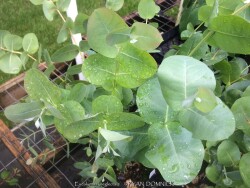

Hardy Eucalyptus, is also known as Eucalyptus neglecta
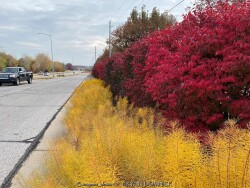

***Shrub descriptions available with future update!*** >>>>> Spring Meadow Nursery says "Better stem hardiness than typical dwarf burning bush. Fire Ball® burning bush is an improved selection of compact burning bush with tighter branching and superior hardiness. Other varieties of burning bush may experience die-back during harsh winters; Fire Ball® euonymus has experienced zero damage even in the coldest of Midwestern winters"
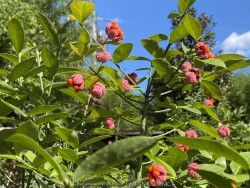

Native Strawberry Bush, is also known as Euonymus americanus
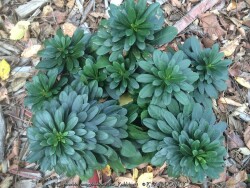

Robbie Spurge (Euphorbia amygdaloides var. robbiae) is grown for its deep green glossy whorled foliage that is very architectural and symetrical. They have everything a gardener might ask for; beautiful spring flowers, dependable dark green foliage, evergreen during winter, pest-free foliage, and ease of care with very low maintenance. Rare greenish-yellow flowers last incredibly long 1 to 2 months and finally turn brown in need of dead-heading. Native to dry woodland locations in Europe, Turkey and the Caucasus, Robbie Spurge tolerates poor soils, including rocky-sandy ones. Root rot can be a problem in poor drainage areas. It prefers average to dry garden conditions with dappled or morning sun. Sun burning is possible with temperatures over 100° so avoid full afternoon sun. Plantings can thrive for many years if in the right spot and there is no such thing as overcrowding. The growth rate is slow at first but eventually forms a nice weed resistant cover so space new plants relatively close together is desiring this effect. Evergreen foliage is hardy to about -10°F with complete death occurring at about -15°F for unmulched plants. Robbie Spurge is less adapted to consistent summer heat and humidity of zone 7b areas or South. With poisonous foliage, these plants resist deer and rabbit browsing. What a great plant for the dry shade garden!
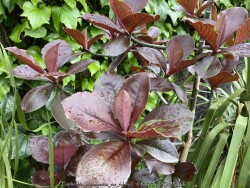

The velvety maroon foliage colors and patterns of Red-leaf African Milk Bush (Euphorbia bicompacta var. rubra) are amazing. Usually used as a patio or house plant in Kansas. Grow in full sun to full shade with optional extra watering including that which comes from rainfall. Plants with time to acclimate will thrive in full sun but be careful not to rush it or sunburning will occur. Generally if moving outside for the summer, allow 2-3 weeks of part shade or morning sun before placing in full sun. Repotting may or may not be needed depending on how large you want the plant to grow; plants can continue to grow taller and tolerate extremely root-bound pots but may need wind bracing. Potted plants are hardy to at least 25 degrees F for a short time if kept dry so you are ok if you miss the first light frost. Do not allow the pot with rootball to freeze solid though. Then move into a cold garage, basement, or bright window over the winter with occasional watering. As a winter house plant, it will look presentable all winter long with just a few waterings. As a permanent house plant, provide bright light and allow the soil to dry between waterings for many years of carefree enjoyment. Potted plants are very low maintenance needing very occasional pruning or topping. Leaves are filled with a milky sap which seems to flow out very vigorously even with only the tiniest injury. All members of the genus Euphorbia produce a milky sap called latex that is toxic and can range from a mild irritant to very poisonous.
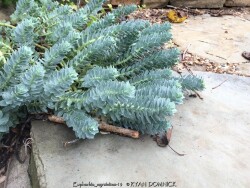

Donkeytail Spurge (Euphorbia myrsinites) is grown for its powder-blue/silver whorled foliage that is very architectural and symetrical. The stems creep along the ground in several directions from the main stem. Beautiful spring flowers are chartruse and foliage is solidly evergreen during winter and completely pest-free. Native to rocky and grassy places of southeastern Europe and Asia Minor, Donkeytail Spurge tolerates a wide range of growing conditions except excess moisture. Performance is best in poor soils, including rocky-sandy ones. Root rot can be a problem in poor drainage areas. It prefers full sun but can also grow well in full dry-shade. Individual plants tend to be short lived so allow some self seeding to occur within the group of plants. Due to self-seeding, it is considered a noxious weed in several western states and should not be planted in those areas. However, it is not a problem in Eastern Kansas or further East areas with over 35 inches of rainfall per year. Do not plant in rich moist soils or root rot will probably occur. Donkeytail Spurge is less adapted to consistent summer heat and humidity of zone 7b Southeast parts of the United States. With poisonous foliage, these plants resist deer and rabbit browsing. Wear gloves when handling this plant and avoid the milky sap. Great plant for berms or clammoring over retaining walls in hot West or South exposures in full sun or the opposite full dry-shade!
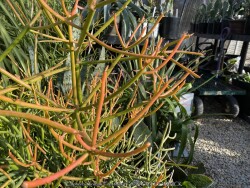

The Pencil Cactus (Euphorbia tirucalli) is a shrub with pencil-thick, green, smooth, succulent branches that provide photosynthesizes long after the foliage is shed. Usually grown as a patio or house plant in Kansas. Grow in full sun to full shade with optional extra watering including that which comes from rainfall. Plants with time to acclimate will thrive in full sun but be careful not to rush it or sunburning will occur. Generally if moving outside for the summer, allow 2-3 weeks of part shade or morning sun before placing in full sun. Repotting may or may not be needed depending on how large you want the plant to grow; plants can continue to grow taller and tolerate extremely root-bound pots but may need wind bracing. Potted plants are hardy to at least 25 degrees F for a short time if kept dry so you are ok if you miss the first light frost. Do not allow the pot with rootball to freeze solid though. Then move into a cold garage, basement, or bright window over the winter with occasional watering. As a winter house plant, it will look presentable all winter long with just a few waterings. As a permanent house plant, provide bright light and allow the soil to dry between waterings for many years of carefree enjoyment. Potted plants are very low maintenance needing very occasional pruning or topping. Stems are filled with a toxic milky sap which seems to flow out very vigorously even with only the tiniest injury. All members of the genus Euphorbia produce a milky sap called latex that is toxic and can range from a mild irritant to very poisonous. Firesticks Pencil Cactus (Euphorbia tirucalli 'Firesticks') is a highly ornamental variety that is more of a chartreuse color with bright orange and red tips developing in response to cold night temperatures.
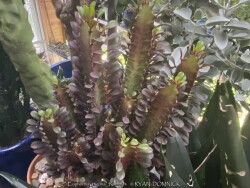

African Milk Tree (Euphorbia trigona) is a an easy care succulent tree that originates from West Africa. Its triangular columns make a fascinating architectural addition to the room or patio. Usually grown as a patio or house plant in Kansas. Grow in full sun to full shade with optional extra watering including that which comes from rainfall. Plants with time to acclimate will thrive in full sun but be careful not to rush it or sunburning will occur. Generally if moving outside for the summer, allow 2-3 weeks of part shade or morning sun before placing in full sun. Repotting may or may not be needed depending on how large you want the plant to grow; plants can continue to grow taller and tolerate extremely root-bound pots but may need wind bracing. Potted plants are hardy to at least 28 degrees F for a short time if kept dry so you are ok if you miss the first light frost. Do not allow the pot with rootball to freeze solid though. Then move into a cold garage, basement, or bright window over the winter with occasional watering. As a winter house plant, it will look presentable all winter long with just a few waterings. As a permanent house plant, provide bright light and allow the soil to dry between waterings for many years of carefree enjoyment. Potted plants are very low maintenance needing very occasional pruning or topping. Stems are filled with a toxic milky sap which seems to flow out very vigorously even with only the tiniest injury. All members of the genus Euphorbia produce a milky sap called latex that is toxic and can range from a mild irritant to very poisonous. No insect pests will bother this plant. Red African Milk Tree Cactus (Euphorbia trigona 'Rubra') is a fabulous red-leaf cultivar with reddish-maroon stems.


Variegated Fallopia, is also known as Fallopia japonica 'Variegata'
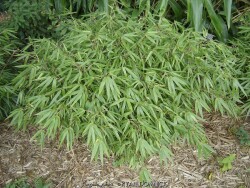

Dragon Head Bamboo (Fargesia rufa) is a wonderful relatively new bamboo introduction with bright green leaves, red sheaths on new canes, and most importantly, a CLUMPING growth habit. This plant creates a soft textured tropical lush appearance in the garden. This unique and interesting plant is evergreen to -5 degree F and grows to about 2-3 feet in Eastern Kansas. (the published 6-10 feet is only achieved in desirable more stable climates like Oregon) Fargesia rufa provides shelter for birds, is not troubled by any diseases, insects, or animals, and is resistant to drought and heat after established. In Eastern Kansas, typically our 40 inches of rainfall is sufficient without extra water if planted in good soils. It is best grown in organically rich, acidic, well-drained soils in part shade but tolerates full shade (not dry-shade). It prefers cool summer climates; although we are on the Southern edge of this plants adaptability, it still survives reasonably well here. Look for a cold microclimate planting location such as East or North exposure. It needs some morning sun but lots of protection from hot afternoon sun. Does not perform well in the hot and humid summers of the southeastern U.S. or anywhere south of zone 6b. I have witnesses plants die in zone 7a from summer heat exhaustion. Mulch in winter will provide protection for the roots and expect occasional die-back when temperatures hit -5 to -10 degrees F. Repeated or successive cold winters with complete foliage loss seem to be an issue with this and many evergreen zone 6/7 plants. One occasional difficult winter followed by mild winters is more tolerable. This plant, however, will generally recover in one summer with decent watering and fertilizer. Plants do not "run" in the landscape like traditional bamboo and are not invasive; think of it as an evergreen ornamental grass with a nice compact fountain-like appearance.
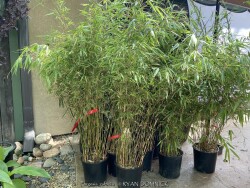

Dragon Head Bamboo (Fargesia rufa) is a wonderful relatively new bamboo introduction with bright green leaves, red sheaths on new canes, and most importantly, a CLUMPING growth habit. This plant creates a soft textured tropical lush appearance in the garden. This unique and interesting plant is evergreen to -5 degree F and grows to about 2-3 feet in Eastern Kansas. (the published 6-10 feet is only achieved in desirable more stable climates like Oregon) Fargesia rufa provides shelter for birds, is not troubled by any diseases, insects, or animals, and is resistant to drought and heat after established. In Eastern Kansas, typically our 40 inches of rainfall is sufficient without extra water if planted in good soils. It is best grown in organically rich, acidic, well-drained soils in part shade but tolerates full shade (not dry-shade). It prefers cool summer climates; although we are on the Southern edge of this plants adaptability, it still survives reasonably well here. Look for a cold microclimate planting location such as East or North exposure. It needs some morning sun but lots of protection from hot afternoon sun. Does not perform well in the hot and humid summers of the southeastern U.S. or anywhere south of zone 6b. I have witnesses plants die in zone 7a from summer heat exhaustion. Mulch in winter will provide protection for the roots and expect occasional die-back when temperatures hit -5 to -10 degrees F. Repeated or successive cold winters with complete foliage loss seem to be an issue with this and many evergreen zone 6/7 plants. One occasional difficult winter followed by mild winters is more tolerable. This plant, however, will generally recover in one summer with decent watering and fertilizer. Plants do not "run" in the landscape like traditional bamboo and are not invasive; think of it as an evergreen ornamental grass with a nice compact fountain-like appearance.
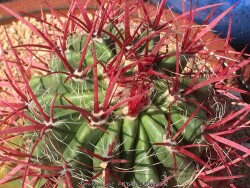

Fire Barrel Cacti (Ferocactus sp.) are known for their bright red spines. Native to the Mojave desert south to the desert of Baja California, it's usually grown as a patio or house plant in Kansas. In the wild, some fire barrel species are hardy to 20 degrees F. Grow in full sun with no extra watering except that which comes from rainfall. Repotting may or may not be needed depending on how large you want the plant to grow; plants can continue to grow taller and tolerate extremely root-bound pots but may need wind bracing. If repotting, make sure to use a sharp draining low organic cactus mix with plenty of sand and perlite. Potted plants are hardy to at least 25 degrees F for a short time if kept dry so you are ok if you miss the first light frost. Do not allow the pot with rootball to freeze solid though. Before extreme cold occurs, move to a bright interior window over the winter with no watering and keep above freezing. As a winter house plant, it will look presentable all winter long with just no waterings.(also to prevent lanky winter growth) As a permanent house plant, provide bright light and allow the soil to dry between waterings for many years of carefree enjoyment. Plants grown permanently indoors may begin to elongate stretching for light and lose their spine color. It can be hard to reproduce the intense UV sunlight they need so moving outside for the summer is best. Generally if moving outside for the summer, allow 1-2 weeks of part shade or morning sun before placing in full sun. Plants with time to acclimate will thrive in full sun but be careful not to rush it or sunburning will occur. Potted plants are very low maintenance but watch for scale and mealybugs that may hide beneath the cover of spines.
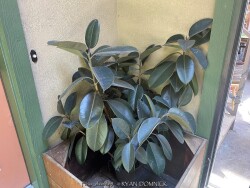

***Description for this plant available with future update!***
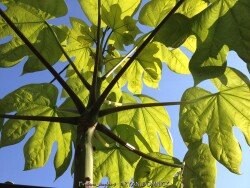

Chinese Parasol Tree (Firmiana simplex) is typically grown as a hardy tropical with huge green leaves and bright green stems that last through winter. This "die to the ground each winter" tree is even more impressive from water strout shoots from the ground. When grown in Kansas, it can be used as summer patio plant tolerating root-boundness well. Water regularly and place in full sun or part shade and enjoy all summer long into late fall. Potted plants are hardy to at least 25 degrees F for a short time if kept dry so you can wait awhile to move these in for the winter. Do not allow the pot with rootball to freeze solid though. Move into a cold garage or basement over the winter. Provide minimal watering and allow the foliage to go dormant and drop off if not already. Bright green stems will remain and add interest during winter. Place back out in April or May with a time-release fertilizer. Landscapers mainly plant Chinese Parasol "Tree" as a die-back to the ground woody perennial "tree". Even without mulch, it is easy to overwinter Firmiana simplex in the ground in Kansas as a woody perennial; complete die-back happens every 1-2 years. The resulting water sprouts from the ground create a bold tropical effect with robust bright green shoots resembling pool cue sticks reaching 5-8' in one season from a 3gal container! We have measured leaves up to 36" long aranded in whorls along the stems. Plants can exceed 15 feet with two consecutive years with no die-back when planted on a South wall. In Eastern Kansas, typically our 40 inches of rainfall is sufficient without extra water in good soils. Chinese Parasol Tree has been planted in our trial gardens and at several residential gardens in Lawrence, KS (zone 6a) 5-10 years ago. During the arctic blast of February, 2021, lows down to -17 degrees F on Feb 16th, 2021 were recorded. The longevity of this cold blast was also impressive: 10 days on a row with highs of 10-15 degrees F or lower, 8 nights of lows in the single digits and negatives, and 36 straight hours of 0 degrees F and mostly lower. Most plants survived with complete die-back and new spring water sprouts. This species is an aggressive, invasive weed in the warmer parts of North America south of zone 7b but not in Kansas because seeds never have a chance to form. Taking 5-7 years to reach flowering size, die-back is much more frequent than that in zone 6. Wow, what a "releaf"!
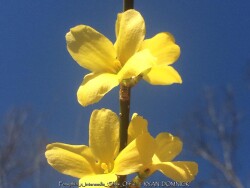

Show Off® Forsythia (Forsythia x Mindor 'Show Off') "shows off" its bright yellow early spring flowers. Improved flower display compared to older varieties. Compact. Deer resistant. Good for cut displays. An excellent specimen plant for mixed borders and foundations. Prefers a good loose soil, but will do well in any soil. pH adaptable and withstands city conditions and is air pollution tolerant. Pruning is best done immediately after flowering. Old stems can be removed or can be cut back to the ground. Shaping should be done at this time. Prefers medium moisture. Fertilize in early spring by applying a slow release fertilizer specialized for trees and shrubs. Follow the label for recommended rate of application. This little beauty will be a blast of early spring color from the ground up! Show Off is not your typical forsythia! It is compact and full of blooms from the ground to the end of every stem. Older varieties can become out of control and often become victims of bad pruning; this little beauty will stay small so there is less need to prune. Now you can have a nice tight, compact forsythia hedge without doing any work! A real improvement over older varieties, Show Off is a very showy choice for the early spring garden. In Eastern Kansas, this cultivar performs WELL with just about everything nature has to challenge it! All Proven Winners® plants are legally propagated, healthy and vigorous, true to name, and tagged with color pictures and growing information.
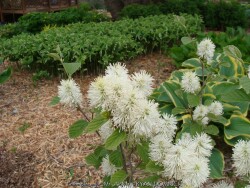

***Shrub descriptions available with future update!***
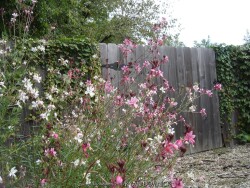

***Description for this perennial available with future update!***
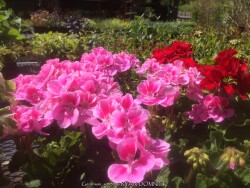

***Description for this plant available with future update!***
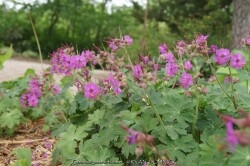

Geranium macrorrhizum, commonly called Bigroot Geranium is native to the Southeast Alps and the Balkans. It features highly aromatic fuzzy leaves that leave you wanting another sniff after crushing a leaf in your hand. Early summer pink, rose, or white flowers form depending on the cultivar. It forms a weed-suppressing mat of rhizomatous semi-evergreen perennial that typically grows to 12" tall but spreads to 24" wide. Root rot can be a problem in poor drainage areas. Bigroot Geranium is the most drought tolerant of the hardy geraniums earning a spot in the dry shade garden; it cannot handle extreme drought or extremely rootbound soils though. It prefers average to dry garden conditions with dappled or morning sun. Sun burning is possible with temperatures over 100° so avoid full afternoon sun. Plantings can thrive for decades if in the right spot as there is no such thing as overcrowding for Big Root Geranium. When planted in mass, growth is slow at first but eventually a cake-like rhizome system will form and completely smother out any weeds and compete well with trees for water and nutrients. The growth rate is slow at first so space new plants relatively close together is desiring this effect.


***Description for this perennial available with future update!***
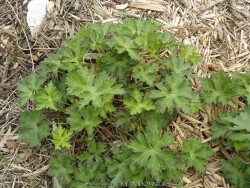

***Description for this perennial available with future update!***
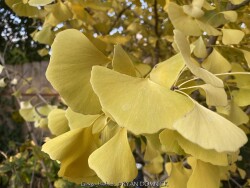

>>>Ginkgo, is also known as Ginkgo biloba. Ginkgo is not tolerant of late-spring frosts, because there are no reserve vegetative buds€â€they leaf out all at once. When such a frost destroys these buds and leaves, it can take until midsummer before the tree has had enough time to produce new ones.
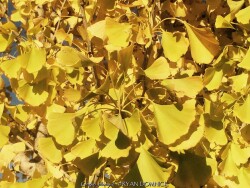

***Tree descriptions available with future update!***


***Shrub descriptions available with future update!*** AVAILABLE 2024!!!
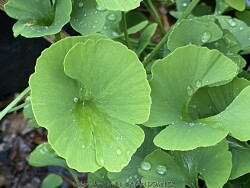

>>>>>Troll Ginkgo Shrub, is also known as Ginkgo biloba 'Troll'. 'Troll' is a dwarf shrubby cultivar that matures over time to only 3' tall and as wide. It typically grows in a bushy mound, although it can be trained to grow as a small pyramidal tree. As with species plants, the fan-shaped leaves (biloba means two-lobed) are rich green to blue green during the growing season, but change to bright yellow in fall.


Raintree Hardy Gladiolus (Gladiolus 'Raintree') are typically grown for their mid-summer flowers and vertical iris-leaf foliage. The plants are temperate and subtropical herbaceous perennial bulbs native to areas with a summer wet season and dry winter. Gladiolus are hardy outside as a perennial when established and with minimal effort at least up to zone 6a. During the growing season, fertilize, water regularly, and plant in full sun. Plant these bulbs in the ground at least 6-8" deep with 3-4" of mulch to enjoy a wonderful tropical flowering effect! Foliage may look bedwraggled by fall so it is ok to cut back foliage at that time. They can also be grown as a flowering summer patio plant. If growing as a potted plant and trying to overwinter, allowing the foliage to frost is ok, it will not kill the root system. However, do not allow the pot with rootball to freeze solid or go below 20 degrees for more than a few hours; move into a cold garage or basement over the winter with no watering. Cut back and allow to go dormant and place entire pot back out in April or May with a time-release fertilizer. Another more labor intensive way to overwinter gladiolus is to remove them from the dirt, dust with fungicide, place in box with sawdust, and keep in the refrigerator. We consider this method old-fashioned and too much work but ok if you only want to save a few bulbs. If digging from the ground in colder zones, just save a big chunk with the dirt intact and place into a large pot in the garage. In a customer's garden in Lawrence, KS (zone 6a), four established specimens planted over 4-6" deep and mulched 2-3" with wood mulch survived -17 degrees F. During the arctic blast of February, 2021, lows down to -17 degrees F on Feb 16th, 2021 were recorded. The longevity of this cold blast was also impressive: 10 days on a row with highs of 10-15 degrees F or lower, 8 nights of lows in the single digits and negatives, and 36 straight hours of 0 degrees F and mostly lower. We plan to propagate these 'Raintree' clones in 2022-2023.
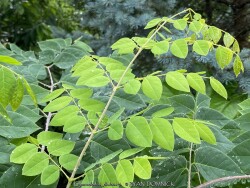

Kentucky Coffeetree, is also known as Gymnocladus dioicus